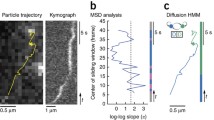Abstract
We provide an analytical tool based on a variational Bayesian treatment of hidden Markov models to combine the information from thousands of short single-molecule trajectories of intracellularly diffusing proteins. The method identifies the number of diffusive states and the state transition rates. Using this method we have created an objective interaction map for Hfq, a protein that mediates interactions between small regulatory RNAs and their mRNA targets.




Similar content being viewed by others
Accession codes
References
Manley, S. et al. High-density map** of single-molecule trajectories with photoactivated localization microscopy. Nat. Methods 5, 155–157 (2008).
Niu, L. & Yu, J. Investigating intracellular dynamics of FtsZ cytoskeleton with photoactivation single-molecule tracking. Biophys. J. 95, 2009–2016 (2008).
English, B.P. et al. Single-molecule investigations of the stringent response machinery in living bacterial cells. Proc. Natl. Acad. Sci. USA 108, E365–E373 (2011).
Bakshi, S., Siryaporn, A., Goulian, M. & Weisshaar, J.C. Superresolution imaging of ribosomes and RNA polymerase in live Escherichia coli cells. Mol. Microbiol. 85, 21–38 (2012).
Bronson, J.E., Fei, J., Hofman, J.M., Gonzalez, R.L. Jr. & Wiggins, C.H. Learning rates and states from biophysical time series: a Bayesian approach to model selection and single-molecule FRET data. Biophys. J. 97, 3196–3205 (2009).
Bishop, C.M. Pattern Recognition and Machine Learning (Springer, 2006).
Das, R., Cairo, C.W. & Coombs, D. A hidden Markov model for single particle tracks quantifies dynamic interactions between LFA-1 and the actin cytoskeleton. PLoS Comput. Biol. 5, e1000556 (2009).
Chung, I. et al. Spatial control of EGF receptor activation by reversible dimerization on living cells. Nature 464, 783–787 (2010).
Beausang, J.F. et al. DNA loo** kinetics analyzed using diffusive hidden Markov model. Biophys. J. 92, L64–L66 (2007).
Mahmutovic, A., Fange, D., Berg, O.G. & Elf, J. Lost in presumption: stochastic reactions in spatial models. Nat. Methods 9, 1163–1166 (2012).
Vogel, J. & Luisi, B.F. Hfq and its constellation of RNA. Nat. Rev. Microbiol. 9, 578–589 (2011).
Waters, L.S. & Storz, G. Regulatory RNAs in bacteria. Cell 136, 615–628 (2009).
Efron, B. Bootstrap methods: another look at the jackknife. Ann. Stat. 7, 1–26 (1979).
Link, T.M., Valentin-Hansen, P. & Brennan, R.G. Structure of Escherichia coli Hfq bound to polyriboadenylate RNA. Proc. Natl. Acad. Sci. USA 106, 19292–19297 (2009).
Fender, A., Elf, J., Hampel, K., Zimmermann, B. & Wagner, E.G. RNAs actively cycle on the Sm-like protein Hfq. Genes Dev. 24, 2621–2626 (2010).
MacKay, D.J.C. Information Theory, Inference, and Learning Algorithms (Cambridge University Press, 2003).
Bronson, J.E., Hofman, J.M., Fei, J., Gonzalez, R.L. Jr. & Wiggins, C.H. Graphical models for inferring single molecule dynamics. BMC Bioinformatics 11 (suppl. 8), S2 (2010).
MacKay, D.J.C. Ensemble learning for hidden Markov models. 〈http://www.inference.phy.cam.ac.uk/mackay/abstracts/ensemblePaper.html〉 (1997).
Ghahramani, Z. An introduction to hidden Markov models and Bayesian networks. in Hidden Markov Models: Applications in Computer Vision (eds. Bunke, H. & Caelli, T.) 9–42 (World Scientific, River Edge, New Jersey, USA, 2001).
Beal, M.J. Variational Algorithms for Approximate Bayesian Inference. PhD thesis, Univ. College London (2003).
Okamoto, K. & Sako, Y. Variational Bayes analysis of a photon-based hidden Markov model for single-molecule FRET trajectories. Biophys. J. 103, 1315–1324 (2012).
Eddy, S.R. What is Bayesian statistics? Nat. Biotechnol. 22, 1177–1178 (2004).
Green, P.J. Reversible jump Markov chain Monte Carlo computation and Bayesian model determination. Biometrika 82, 711–732 (1995).
Robert, C.P., Rydén, T. & Titterington, D.M. Bayesian inference in hidden Markov models through the reversible jump Markov chain Monte Carlo method. J. R. Stat. Soc., B 62, 57–75 (2000).
Acknowledgements
We thank I. Barkefors for her careful and critical reading of the manuscript. M.L. is grateful to C.H. Wiggins and J.-W. van de Meent for insightful discussions. This work was supported by the European Research Council (J.E.), the Knut and Alice Wallenberg Foundation (J.E.), Vetenskapsrådet (J.E.), the Göran Gustafsson Foundation (J.E.), the Wenner-Gren Foundations (M.L.) and the Center for Biomembrane Research (M.L.).
Author information
Authors and Affiliations
Contributions
J.E. and M.L. conceived the method, M.L. designed the vbSPT algorithm, M.L. and F.P. implemented and tested the algorithm, F.P. designed and implemented the image analysis and particle-tracking algorithms, and C.U. cloned and characterized the bacterial strains. F.P. and J.E. built the optical setup. F.P., C.U. and J.E. designed the experiments, and C.U. and F.P. performed the experiments. F.P., M.L., C.U. and J.E. wrote the manuscript.
Corresponding author
Ethics declarations
Competing interests
The authors declare no competing financial interests.
Supplementary information
Supplementary Text and Figures
Supplementary Tables 1–7 and Supplementary Notes 1–5 (PDF 1053 kb)
Supplementary Software
vbSPT (variational Bayes single-particle tracking) software (ZIP 6389 kb)
Rights and permissions
About this article
Cite this article
Persson, F., Lindén, M., Unoson, C. et al. Extracting intracellular diffusive states and transition rates from single-molecule tracking data. Nat Methods 10, 265–269 (2013). https://doi.org/10.1038/nmeth.2367
Received:
Accepted:
Published:
Issue Date:
DOI: https://doi.org/10.1038/nmeth.2367
- Springer Nature America, Inc.





